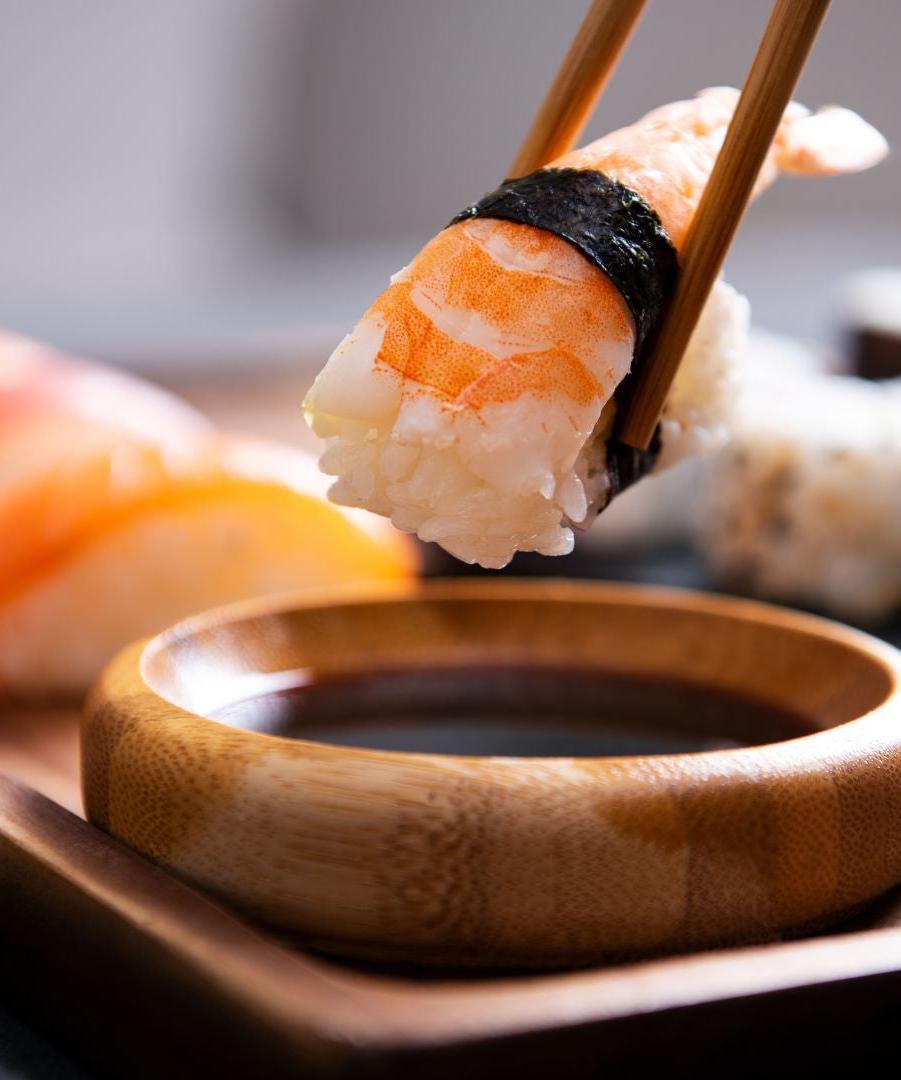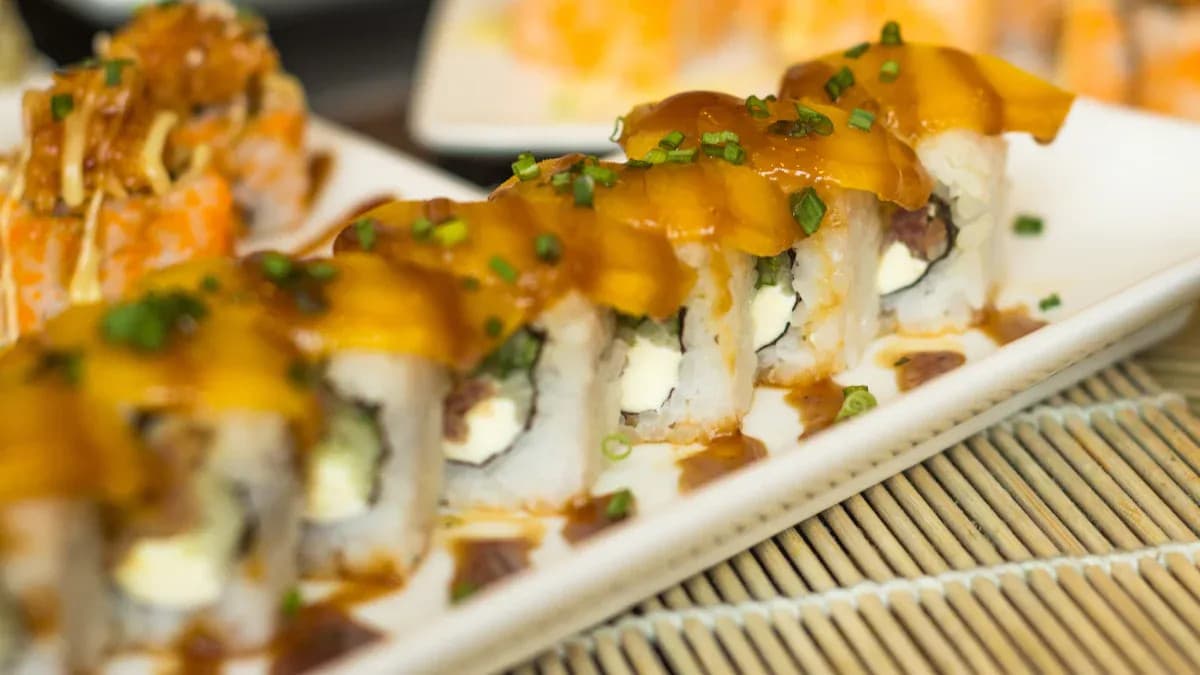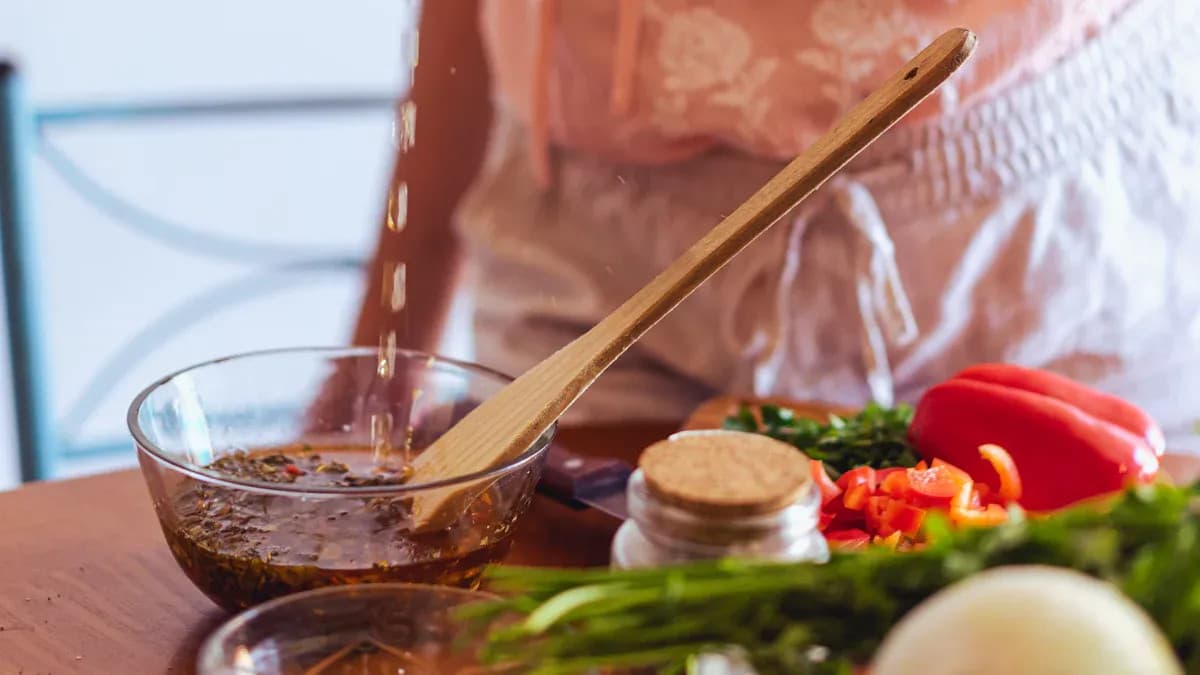


You might notice how rice vinegar, red vinegar, and sweetened vinegar each bring a punch of flavor to your cooking. These vinegars have become kitchen staples, especially as more people explore Asian-inspired dishes at home. Recent trends show that rice vinegar, including red rice vinegar, is gaining fans fast. Its mild, sweet, and sometimes complex taste fits right into everything from classic sushi to creative salads. Sweetened vinegars are also making waves, with specialty blends popping up in supermarkets and online stores. You can always find new ways to use these vinegars, whether you want to try Best Recipes or simply add a fresh twist to your meals.
Try displaying a vibrant image of all three vinegars with fresh herbs, vegetables, and sushi rice to inspire your next dish!

Rice vinegar stands out as a must-have in your kitchen. You can use it in so many ways, and it always brings a gentle tang and a touch of sweetness to your food. Let’s dive into some of the Best Recipes where rice vinegar truly shines.
You can’t make authentic sushi without perfectly seasoned rice. Rice vinegar gives sushi rice its signature flavor. Start by cooking short-grain rice until it’s fluffy. While the rice is still warm, mix in a blend of rice vinegar, sugar, and salt. This mixture adds a mild acidity and a hint of sweetness that balances the rice. If you want to save time, try seasoned rice vinegar. It already contains sugar and salt, so you can just pour and mix. Sushi rice works as the base for sushi rolls, poke bowls, or even as a side dish for grilled fish.
Tip: Use a wooden paddle and a wide bowl to mix the rice gently. This keeps the grains from getting mushy.
Rice vinegar makes Asian salads pop with flavor. Its mild acidity doesn’t overpower fresh greens or crunchy veggies. You can whisk it with a little sesame oil, soy sauce, and a pinch of sugar for a quick dressing. Toss it with shredded cabbage, carrots, and scallions for a refreshing slaw. Many home cooks love using rice vinegar in salads because it’s light and lets the natural flavors shine.
So, when you reach for rice vinegar in your next salad, you’re not just adding flavor—you’re making a smart choice for your health.
Quick pickles are one of the best recipes for rice vinegar. You can pickle almost any vegetable—cucumbers, radishes, carrots, or daikon. Slice your veggies, then soak them in a mix of rice vinegar, water, sugar, and salt. Let them sit for at least an hour. The result? Crisp, tangy pickles that brighten up any meal.
You can use these pickles in rice bowls, sandwiches, or as a crunchy snack.
Rice vinegar works wonders in marinades. Its gentle acidity helps tenderize meat, chicken, or tofu without making them tough. Mix rice vinegar with soy sauce, ginger, garlic, and a touch of honey for a simple marinade. Let your protein soak for at least 30 minutes. The result is juicy, flavorful food that cooks up beautifully on the grill or in a pan.
You can also use seasoned rice vinegar for a quick flavor boost. It’s perfect when you want to whip up a marinade in minutes. Try it with shrimp, pork, or even roasted vegetables.
Suggestion: Show an image of sushi rice, a vibrant Asian salad, and a jar of colorful pickled vegetables to inspire your next meal.
You’ll find that these Best Recipes highlight the versatility of rice vinegar. Whether you’re making sushi, tossing a salad, pickling veggies, or marinating meat, rice vinegar brings out the best in every dish.
Red vinegar brings a bold, complex flavor to your kitchen. You might know it from Chinese cuisine, but you can use it in many dishes. Its sweet, tart, and salty notes make it a star in both classic and modern recipes. Let’s explore some of the Best Recipes where red vinegar truly shines.
You can’t enjoy dumplings without a good dipping sauce. Red vinegar gives your sauce a deep, tangy kick that balances salty soy sauce and spicy chili oil. Just mix red vinegar with soy sauce, a splash of sesame oil, and a pinch of sugar. Add minced garlic or chopped scallions for extra flavor. This sauce works with pork, chicken, or veggie dumplings. You’ll notice how the vinegar cuts through the richness and brings out the filling’s taste.
Tip: Try adding a few drops of chili oil if you like heat. Red vinegar’s mellow acidity keeps the sauce from tasting too sharp.
Red vinegar transforms braised pork into a melt-in-your-mouth dish. You start by browning pork belly or shoulder in a pot. Pour in red vinegar, soy sauce, sugar, and ginger. Let the pork simmer until it turns tender and the sauce thickens. The vinegar helps break down the meat and adds a subtle tang that balances the fat. You get a glossy, flavorful sauce that clings to every bite.
Many home cooks love this dish because it feels comforting and special. Red vinegar’s unique taste sets it apart from other braised meats. Serve it with steamed rice or noodles for a complete meal.
Red vinegar brings noodle soups to life. You can add a splash to hot and sour soup, beef noodle soup, or even wonton soup. The vinegar brightens the broth and adds depth without overpowering the other flavors. Just pour a little into your bowl before eating, or offer it on the side for everyone to adjust to their taste.
Some noodle shops in China keep a bottle of red vinegar on every table. You can do the same at home. Try it with hand-pulled noodles, rice noodles, or even ramen. The sweet and tart notes make every slurp more exciting.
You can use red vinegar to finish a stir-fry. Toss your cooked meat and vegetables with a splash of vinegar right before serving. The heat releases the vinegar’s aroma and coats everything in a glossy, tangy glaze. Red vinegar pairs well with beef, chicken, or tofu. It also works with crunchy veggies like bell peppers, snap peas, and carrots.
If you want to try new Best Recipes, experiment with red vinegar in your favorite stir-fry. You’ll notice how it lifts the flavors and adds a restaurant-quality touch.
Suggestion: Show an image of juicy dumplings, glossy braised pork, and a steaming bowl of noodle soup to inspire your next meal.
Red vinegar deserves a spot in your pantry. You can use it in sauces, braises, soups, and stir-fries. Its sweet, tart, and salty profile makes it a key ingredient in many Best Recipes from Chinese cuisine and beyond.

Sweetened vinegar brings a playful twist to your kitchen. You can use it to create bold sauces, quick pickles, shiny glazes, and even dressings for fruit. Let’s look at some tasty ways to use sweetened vinegar in your cooking.
You probably know sweet and sour sauce from your favorite takeout. You can make it at home with sweetened vinegar, ketchup, sugar, and a splash of soy sauce. This sauce tastes great with chicken, pork, or tofu. It gives your dish a tangy kick and a glossy finish. You can also use it as a dip for spring rolls or fried shrimp.
Tip: Add pineapple chunks or bell peppers for extra color and flavor.
Quick pickles are easy and fun. Slice cucumbers, carrots, or radishes. Pour sweetened vinegar over them. Let them chill in the fridge for an hour. You get crunchy, tangy snacks that brighten any meal. The global pickles market reached $14.21 billion in 2024 and keeps growing. People love pickles for their bold flavors and health benefits. In the U.S., the pickles market hit $3.1 billion this year. Many food lovers now look for sweet and spicy varieties, making quick pickles with sweetened vinegar a top choice.
You can brush sweetened vinegar on roasted meats for a shiny, flavorful glaze. Try it on pork, chicken, or duck. The sugar in the vinegar caramelizes in the oven. Your roast comes out with a beautiful color and a sweet-tart taste. In Chinese cooking, pig’s trotters in ginger and sweetened vinegar is a classic dish. The vinegar softens the meat and adds a rich, comforting flavor.
Sweetened vinegar makes fruit salads pop. Whisk it with a little honey and fresh mint. Drizzle over berries, melon, or citrus. The vinegar balances the sweetness of the fruit and adds a gentle tang. Your fruit salad will taste fresh and exciting.
Suggestion: Show an image of sweet and sour chicken, a glossy glazed roast, and a colorful fruit salad to inspire your next meal.
Choosing the right vinegar can make your food taste brighter and more balanced. You might wonder which vinegar goes best with certain dishes. Here are some quick pairing ideas to help you out:
Acidity from vinegars helps balance out rich or fatty foods. For example, a vinaigrette on a buttery avocado salad brightens every bite. Chefs also love pairing roast lamb with mint and sherry vinegar to create a more rounded taste.
You can experiment with these pairings to find what you like best. Vinegar’s acidity often prevents dishes from feeling too heavy and keeps flavors lively.
Sometimes you run out of a specific vinegar. Don’t worry—you have options! Many culinary experts recommend simple swaps that keep your dish tasting great. Here’s a handy chart for quick substitutions:
| If You Don’t Have... | Try This Instead | Ratio | Notes |
|---|---|---|---|
| Rice Vinegar | Apple Cider Vinegar | 1:1 | Add a pinch of sugar for sweetness |
| Red Vinegar | Balsamic or Sherry Vinegar | 1:1 | Use for braises and sauces |
|
Sweetened Vinegar |
Rice Vinegar + Sugar | 1 tbsp + ½ tsp sugar | Mix before adding to your recipe |
You might want to display an image of vinegar bottles next to foods they pair with, or a simple substitution chart for easy reference.
With these tips, you can confidently swap vinegars and still enjoy delicious, balanced meals every time.
You’ve seen how rice, red, and sweetened vinegars can transform your cooking. These vinegars add flavor, color, and even health benefits to your favorite dishes.
Try these recipes at home and experiment with your own ideas. Share your favorite vinegar tips or recipes in the comments!
Imagine a plate of glossy sweet and sour chicken or a bowl of sushi rice—your next meal could look just as inviting.
Yes, you can swap rice vinegar for white vinegar in most recipes. Rice vinegar tastes milder and sweeter. If you want a closer match, add a pinch of sugar to balance the flavor.
Red vinegar tastes sweet, tart, and a bit salty. Black vinegar has a deeper, smoky flavor. You’ll find red vinegar in dumpling sauces and noodle soups. Black vinegar works best in braised dishes and dipping sauces.
Keep your vinegars in a cool, dark place. You don’t need to refrigerate them. Make sure the cap stays tight. This way, your vinegar keeps its flavor for months.
Absolutely! Just mix rice vinegar with sugar. Try this simple ratio:
| Rice Vinegar | Sugar |
|---|---|
| 1 cup | 3–4 tbsp |
Stir until the sugar dissolves. Now you have sweetened vinegar for sauces and dressings.
Most rice and sweetened vinegars are gluten-free. Some red vinegars may contain wheat. Always check the label if you have gluten concerns.
Hi! Click one of our members below to chat on